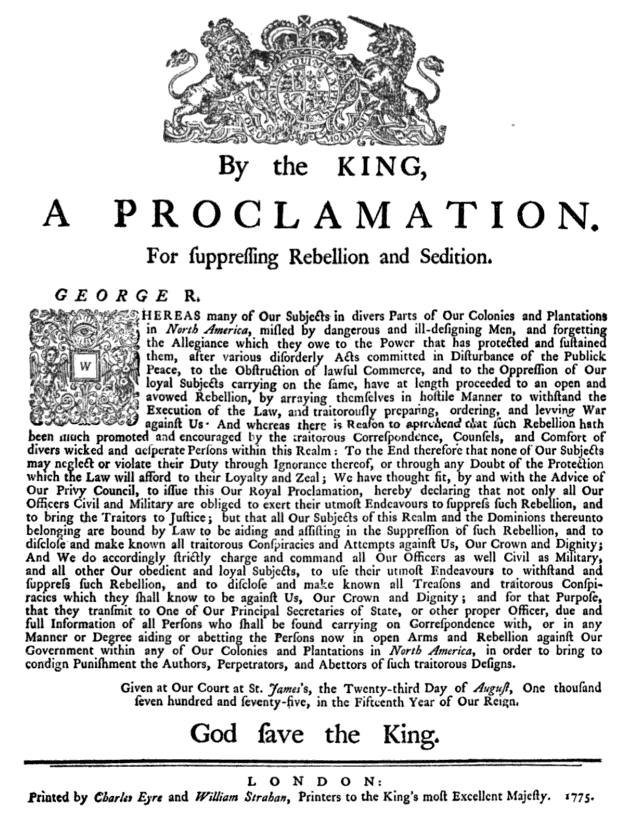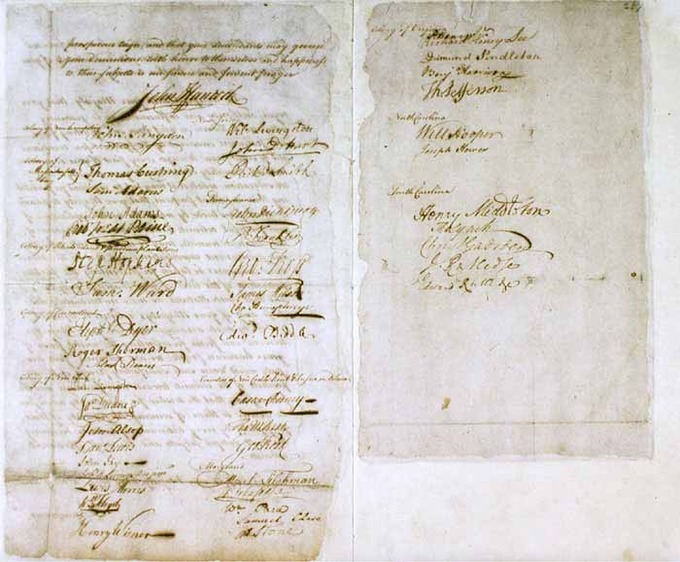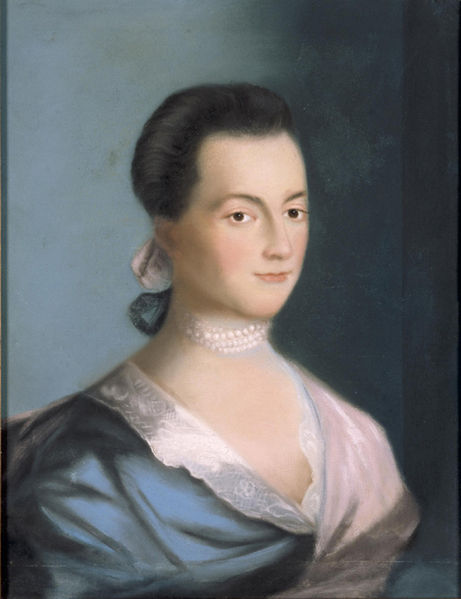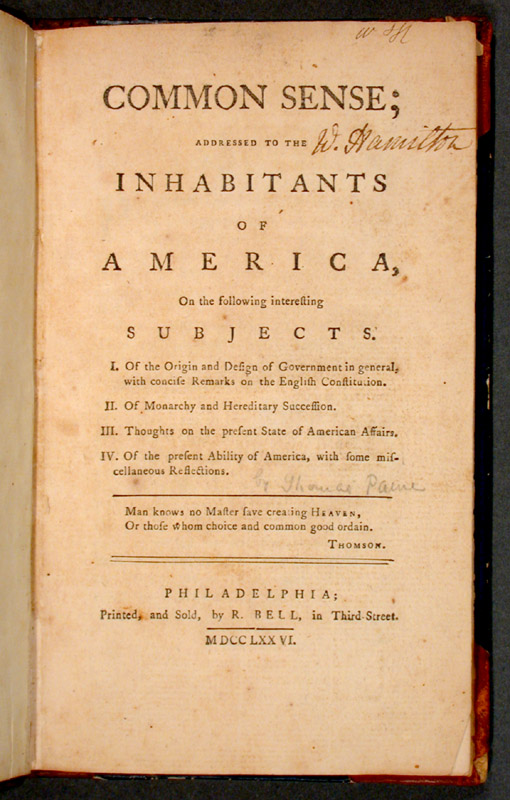Why Did Congress Meet Again for 2nd Continental Congress
The Second Continental Congress
During the Revolutionary War, the Second Continental Congress acted equally the national government of the Xiii Colonies in rebellion.
Learning Objectives
Draw the piece of work of the Second Continental Congress
Key Takeaways
Cardinal Points
- The 2nd Continental Congress was composed of many of the same delegates as the First Continental Congress, including the Founding Fathers.
- The Second Congress managed the colonial war effort, financing the war with borrowed funds and without the support of taxes; states were asked to contribute men, supplies, and funds.
- With the guidance of Congress, the Patriots moved incrementally towards independence, adopting the United States Declaration of Independence on July 4, 1776.
- Congress lacked the power to levy taxes and struggled to finance the Revolutionary War.
- With the ratification of the Manufactures of Confederation, the Congress became known as the Congress of the Confederation.
- In June 1775, Congress created the Continental Ground forces and gave command of the Army to George Washington.
Key Terms
- Benjamin Franklin: A prominent Founding Male parent and a representative of the U.s.a. at the signing of the Peace of Paris.
- Patriots: In the context of the American Revolution, the colonists who rebelled against British control and declared their independence at the United states of america of America in July 1776. They are also referred to as Revolutionaries, Continentals, Rebels, or American Whigs.
- 2d Continental Congress: The Second Continental Congress was a convention of delegates from the xiii colonies that started meeting on May 10, 1775, in Philadelphia, Pennsylvania, soon after the American Revolutionary State of war had begun.
- Thomas Jefferson: An American Founding Begetter, the primary writer of the Declaration of Independence (1776), and the third President of the United states of america (1801–1809).
The 2nd Continental Congress was a convention of delegates from the 13 colonies that formed in Philadelphia in May 1775, shortly later the launch of the American Revolutionary State of war. It succeeded the Get-go Continental Congress, which met between September and Oct of 1774.
The First Continental Congress petitioned King George Iii to repeal the Intolerable Acts (punitive measures passed by Parliament in response to the Boston Tea Party) and initiated a cold-shoulder of British goods. The Get-go Congress established that the Second Continental Congress would convene on May 10, 1775.
Many of the aforementioned 56 delegates present at the First Continental Congress were in attendance at the Second Congress. The delegates reappointed former Continental Congress president, Peyton Randolph, and secretary, Charles Thomson, to reprise their roles at the 2nd Congress. Randolph was before long chosen abroad past other duties and succeeded past John Hancock as president. Other notable members of the Congress included Thomas Jefferson, Benjamin Franklin, and John Adams.
By the time the Second Continental Congress met, the American Revolutionary War was already underway. For the start few months of this conflict, the Patriots had carried on their struggle in an ad-hoc and uncoordinated style. At this point, Congress intervened and assumed leadership of the war endeavor.
On June fourteen, 1775, Congress voted to create the Continental Army from Boston militia units. Congressman George Washington of Virginia was appointed commanding general of the army. On July 6, 1775, Congress approved a Announcement of Causes outlining the rationale and necessity for taking up arms in the thirteen colonies. On July viii, Congress extended the Olive Branch Petition to the British Crown as a concluding, unsuccessful try at reconciliation.
The Congress assumed all the functions of a national government, such as appointing ambassadors, signing treaties, raising armies, appointing generals, obtaining loans from Europe, and disbursing funds. In the concurrently, the 2d Continental Congress tried to lead the new state through the war with borrowed funds and no say-so to levy taxes. The Congress relied on money, supplies, and troops from the states to support the state of war endeavour; however, individual states ofttimes ignored requests for support.
In September 1777, the Continental Congress was forced to relocate to York, Pennsylvania, as British troops occupied the city of Philadelphia.

Announcement of Independence by John Trumbull, 1819: The resolution for independence was amongst the most important accomplishments of the 2nd Continental Congress.
Pursuing Both State of war and Peace
In 1775, the colonies proposed the Olive Branch Petition to reconcile with Britain and avert war, just King George III denied the petition.
Learning Objectives
Draw the relationship between the colonies and Peachy U.k. in the year before the Annunciation of Independence
Central Takeaways
Fundamental Points
- The 2nd Continental Congress, guided past Pennsylvania consul John Dickinson, swore loyalty to the Crown and requested tax reforms in the Olive Branch Petition. This petition was a final endeavour past the Congress to avoid war with Bully Britain.
- The Olive Co-operative Petition vowed allegiance to the Crown and claimed that the colonies did not seek independence—they merely wanted to negotiate trade and tax regulations with Neat United kingdom.
- The petition asked for one of 2 alternatives: free merchandise and taxes equal to those levied on the people in Great Britain, or alternatively, no taxes and strict trade regulations.
- Dickinson's petition was non unanimously accepted by Congress. John Adams, leading a smaller faction of delegates, opposed Dickinson; he and his followers viewed state of war as inevitable.
- After the Battle of Bunker Hill, in which the British suffered massive casualties, King George Three issued a Announcement for Suppressing Rebellion and Sedition in August 1775.
- The rex'due south proclamation declared the 13 colonies to be in a land of revolt. He ordered British officers and loyal subjects to suppress this uprising.
- The hostility of King George III weakened the colonists' attachment to Great Great britain and strengthened the move for independence.
Key Terms
- Olive Co-operative Petition: Adopted by the Continental Congress in July 1775, in a final attempt to avoid war with Great Britain.
- Proclamation of Rebellion: Officially titled "A Proclamation for Suppressing Rebellion and Sedition," was the response of George Three of Nifty U.k. to the news of the Boxing of Bunker Hill at the outset of the American Revolutionary War.
- Battle of Bunker Loma: Occurred on June 17, 1775, mostly on and effectually Brood's Hill, during the Siege of Boston early on in the American Revolutionary War.
In the period of uncertainty leading up to the formal proclamation of war, the 2d Continental Congress attempted to pacify the British and declare allegiance to the Crown, while simultaneously asserting independence and engaging British forces in armed disharmonize.
When the Second Continental Congress convened in May 1775, near delegates supported John Dickinson in his efforts to reconcile with George Three of Bully Great britain. However, a small-scale faction of delegates, led past John Adams, argued that war was inevitable.
The Olive Branch Petition was adopted by the Continental Congress in July 1775, in an attempt to avert a war with Great Britain. The petition vowed allegiance to the Crown and entreated the king to forestall farther disharmonize, challenge that the colonies did not seek independence but merely wanted to negotiate trade and tax regulations with Peachy Britain. The petition asked for gratis merchandise and taxes equal to those levied on the people in Great U.k., or alternatively, no taxes and strict trade regulations. The letter was sent to London on July 8, 1775. The petition was rejected, and in Baronial 1775, A Proclamation for Suppressing Rebellion and Sedition (or the Proclamation of Rebellion ) formally declared that the colonies were in rebellion.
The Annunciation of Rebellion was written before the Olive Co-operative Petition reached the British. When the petition arrived, it was rejected unseen by King George Iii, and the 2d Continental Congress was dismissed every bit an illegal associates of rebels. At the same time, the British besides confiscated a letter authored past John Adams, which expressed frustration with attempts to make peace with the British. This letter was used as a propaganda tool to demonstrate the insincerity of the Olive Branch Petition.
The king'southward rejection gave Adams and others who favored revolution the opportunity they needed to push for independence. The rejection of the "olive co-operative" polarized the issue in the minds of many colonists who realized that from that signal frontward, the pick was between full independence or full submission to British rule.
In Baronial 1775, upon learning of the Boxing of Bunker Loma, Rex George III issued a Proclamation for Suppressing Rebellion and Sedition. This document alleged the North American colonies to be in a state of rebellion and ordered British officers and loyal subjects to suppress this uprising.
On October 26, 1775, King George Three expanded on the Declaration of Rebellion in his Speech from the Throne at the opening of Parliament. The male monarch insisted that rebellion was existence fomented by a "desperate conspiracy" of leaders whose claims of allegiance to him were not 18-carat. King George indicated that he intended to deal with the crisis with armed force.

Announcement of Rebellion, 1775: The Proclamation of Rebellion was Rex George 3's response to the Olive Branch Petition.
The 2d Continental Congress issued a response to the Announcement of Rebellion on Dec vi, 1775, maxim that despite their unwavering loyalty to the Crown, the British Parliament did not have a legitimate claim to authority over the colonies while they did not have democratic representation. The Second Continental Congress maintained that they still hoped to avert a "civil war."

Olive Co-operative Petition, 1775: The Olive Branch Petition, issued by the Second Congress, was a last effort at reconciliation with the British.
The Declaration of Independence
In 1776, revolution was fomented by Thomas Paine, who wrote Common Sense; and by Abigail Adams, who advocated for women'southward rights. Both individuals influenced the evolution of the U.S. Declaration of Independence.
Learning Objectives
Identify the key points in the Declaration of Independence
Key Takeaways
Cardinal Points
- Common Sense, a pro-revolutionary pamphlet written by Thomas Paine, brought the subject of independence and the ideas of republicanism into public discourse.
- Common Sense
was widely read in the yr of its publication and bolstered enlistment in the Continental Army.
- Abigail Adams raised questions about the future role for women in the Republic and publicly brought this issue to her husband John Adams during his participation in the Second Continental Congress.
- Paine donated the royalties from Common Sense to George Washington 's Continental Army.
- Abigail Adams asked John Adams to consider representation for women in the new republic.
Central Terms
- Mutual Sense: Common Sense is the championship of a pamphlet written by Thomas Paine that was published anonymously at the beginning of the American Revolution, advocating for colonial independence from Great Great britain in plain linguistic communication that made the message accessible to the common people of America.
- Abigail Adams: The wife of John Adams, the 2nd President of the United States, and the mother of John Quincy Adams, the sixth.
- coverture: A common constabulary doctrine adult in England during the Heart Ages, whereby a woman'south legal being upon marriage was subsumed past that of her husband, particularly with regard to ownership of property and protection.
- Thomas Paine: An English-American political activist, political theorist, and theologian. As the author of two highly influential pamphlets at the start of the American Revolution, he became i of the Founding Fathers of the U.s.a..
- Republican Maternity: A 20th-century term for the emerging civic roles played by revolutionary-era women as custodians of the virtues of republicanism.
Development of the Announcement of Independence
On June vii, 1776, Richard Henry Lee of Virginia presented a three-part resolution to Congress. His move chosen upon Congress to declare independence, grade foreign alliances, and fix a programme for colonial confederation. Lee'south resolution was met with debate. Opponents of Lee's resolution argued that although reconciliation with Slap-up Britain was unlikely, the timing was premature to declare independence and Congress ought to focus on securing foreign aid. Proponents of Lee's resolution, nonetheless, argued that foreign governments were unlikely to grant assistance to a party to an internal British struggle, making a formal annunciation of independence even more than urgent. Moreover, many members of Congress already viewed the thirteen colonies as de facto contained, making the declaration a mere formality rather than a revolutionary break from what already had been. The debate remained heated, with some members of Congress threatening to leave should such a resolution be adopted, so the motion was tabled for 3 weeks. In the concurrently, it was decided that a committee should be formed to draft a document announcing and explaining colonial independence should Lee's resolution somewhen be approved.
The text of the Annunciation of Independence was drafted by a "Committee of Five" appointed past Congress, which consisted of John Adams of Massachusetts, Benjamin Franklin of Pennsylvania, Thomas Jefferson of Virginia, Robert R. Livingston of New York, and Roger Sherman of Connecticut. Jefferson was chosen past the committee as the primary author after a general outline was agreed to amidst the v, and a draft was presented to Congress on June 28, 1776. The official title given to the document was "A Announcement by the Representatives of the U.s.a., in General Congress Assembled." For two days following, the document was edited by Congress, the principal change existence a moderation of Jefferson'southward claim that Britain had forced slavery in the colonies.
Notable Figures of the Revolutionary Era
Beyond the Second Congress, many colonists shared concerns almost British dominion and what independence would hateful for the future. Thomas Paine and Abigail Adams were two singled-out, populist voices upholding the crusade of independence during this time.
Thomas Paine
In January 1776, Thomas Paine published a pro-independence pamphlet entitled Common Sense, which became an overnight sensation. This work presented the American colonists with an statement for freedom from British rule at a time when the question of independence was still undecided. To escape governmental censure for its treasonous content, Paine published Common Sense anonymously. The pamphlet sold as many as 120,000 copies in the start three months, 500,000 in the outset year, and went through 25 editions in the first yr of publication. Paine donated his royalties from Mutual Sense to George Washington'due south Continental Army.
Though the themes of the pamphlet were familiar to the elite who comprised Congress and the leadership cadre of the emerging nation, Common Sense was a crucial tool for increasing popular discourse concerning independence. This pamphlet was responsible for broadly disseminating the thought of republicanism, bolstering enthusiasm for separation from United kingdom, and encouraging recruitment for the Continental Ground forces.
Abigail Adams
Abigail Adams was an advocate for married women's property rights and greater opportunity for women, particularly in respect to education. Adams was especially interested in what implications independence from Britain held for women and women's rights.

Abigail Adams, by Benjamin Blythe, 1766: Abigail Adams was greatly concerned about the role of women in the new commonwealth.
In March 1776, Adams addressed her husband, John Adams, and the Continental Congress in a letter in which she requested that they, "remember the ladies, and be more generous and favorable to them than your ancestors. Do non put such unlimited ability into the hands of the Husbands. Recollect all Men would be tyrants if they could. If particular care and attention is not paid to the Ladies we are adamant to foment a Rebellion, and volition non hold ourselves spring by whatever Laws in which we have no vocalism, or Representation."
Women and Independence
For the most part, revolutionary-era women's contributions to politics were limited to the individual realm and women were dependent upon male person relatives to vox their concerns and opinions in the public realm through a centuries-onetime do termed coverture. However, women were also increasingly put in the position of educating future generations in the means of republicanism during this time. The " Republican Motherhood" came to cover the concept that women played a role in instilling civil values and morality in their husbands and children. In this way, Republican Motherhood, though withal relegating women's contributions to the domestic, or private sphere, raised the importance of women'southward civic contributions on a national level and encouraged the farther educational activity of women.

Common Sense, 1776: Thomas Paine'due south widely read, 46-folio pamphlet finer argued for independence.
Licenses and Attributions
Source: https://courses.lumenlearning.com/boundless-ushistory/chapter/the-second-continental-congress/
0 Response to "Why Did Congress Meet Again for 2nd Continental Congress"
Post a Comment